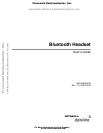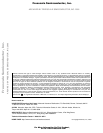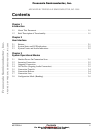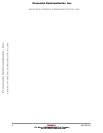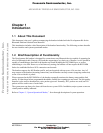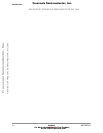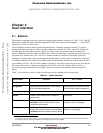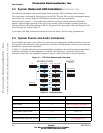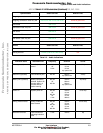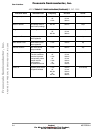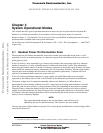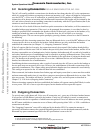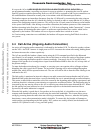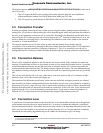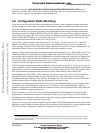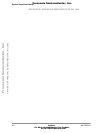
ARCHIVED BY FREESCALE SEMICONDUCTOR, INC. 2005
ARCHIVED BY FREESCALE SEMICONDUCTOR, INC. 2005
3-2 Headset MOTOROLA
Preliminary
System Operational Modes
3.2 Incoming Connection
The AG will usually establish a connection to the headset no later than when the AG, or the equipment to
which it is connected, initiates an outgoing or detects an incoming “call”, where call might be a connection
over the POTS
2
, a Voice-over-IP connection, or a mobile phone call. Regardless of whether the AG
initiates the call or detects an incoming call, the Bluetooth connection to the headset will be initiated by the
AG, and is thus referred to as an incoming connection in conformity with the BT specification (that is, the
situation is seen from the headset point-of-view).
It is left to the AG to decide if the user should accept the connection on the headset, or if the connection is
just added without user interaction. If the user is to be prompted for acceptance, it can either be done by
sending a specified RING command to the headset, which will then issue a ring tone in the headset, or by
sending an in-band ring tone to the headset. To repeat the alert, the AG will have to re-issue the
command/ring tone. The user can accept the prompt by pressing a button, referred to as the BT button in
the following.
The headset will allow incoming connections from any Bluetooth device, even if the BD
3
addresses of one
or more specific devices are stored in the headset. Stored addresses are only used when the headset
establishes the connection (see Chapter 3.3, “Outgoing Connection” below).
If the AG requires link level security, the connection can only be accepted if the headset already holds a
link key, which will be the case if the AG address has previously been stored in the headset, and the AG at
this time requested the use of authentication. In this situation, the headset and AG are said to be bonded to
each other, and the process of establishing a bond is referred to as pairing, in Bluetooth terms. Thus, in this
situation, the process of storing the AG address in the headset is the equivalent of pairing the headset and
AG. The headset can be paired to up to two AGs at a time. Additional devices can still connect to the
headset, but without the use of authentication.
Establishing the data connection may take a couple of seconds since the AG has to scan for the headset as
the two units may not necessarily be in sync. However, the establishment of the audio connection will be
practically instantaneous. The volume setting stored when the headset was last connected is used initially.
This setting was reported to the AG when the data link was established.
When connected, the headset abstains from further page and inquiry scans (that is, enters non-discoverable
and non-connectable mode) since it is not able to connect to more than one Bluetooth device at a time. This
also saves power. The headset will then be “invisible” to other AGs, and will operate as described in
Chapter 3.4, “Call Active (Ongoing Audio Connection)”.
When an incoming connection has been established, the headset will request entering Sniff Mode, in order
to save power. The AG is free to reject this request, but the headset will not repeat the request.
3.3 Outgoing Connection
To actively start a call (phone call, Voice-over-IP connection, etc.), press any of the three headset buttons
if at least one AG BD address is stored in the headset. If only one AG address is stored, a connection is
established to this device regardless of which button was pressed. If two AG addresses are stored, pressing
the BT button establishes a connection to one of them, while pressing either VOL+ or VOL- establishes a
connection to the other.
The “Outgoing Connection” state will be indicated by the headset LED. If a connection attempt is
successful, the headset connects the required Bluetooth protocols over the baseband connection, and the
Bluetooth key-press command specified in the BT specification is sent to the AG.
2. Plain Old Telephone System, that is, an analogue phone line, etc.
3. Bluetooth Device address, a universally unique ID number identifying each Bluetooth unit.
Freescale Semiconductor, I
Freescale Semiconductor, Inc.
For More Information On This Product,
Go to: www.freescale.com
nc
.
..



